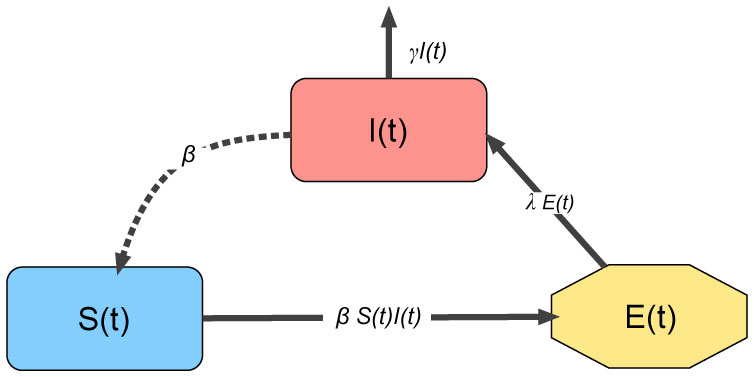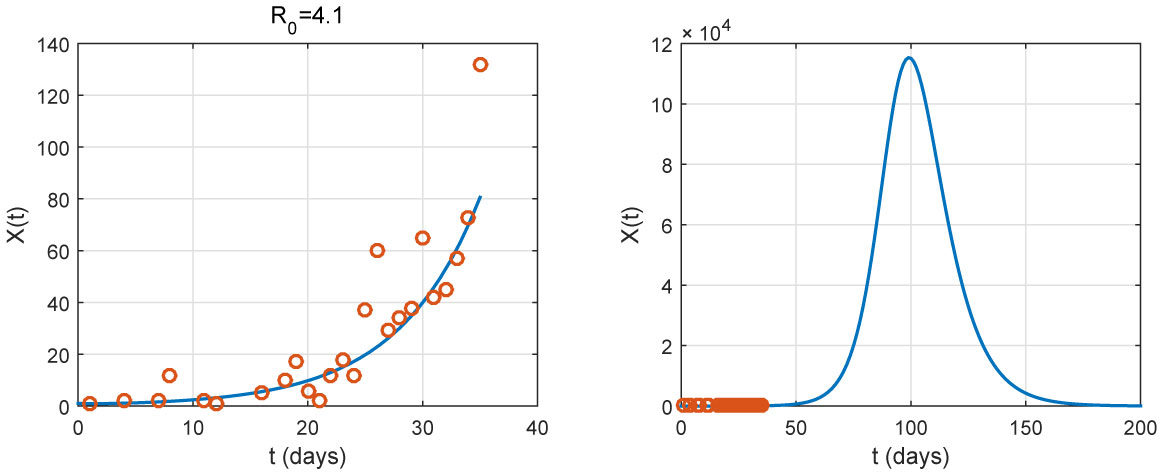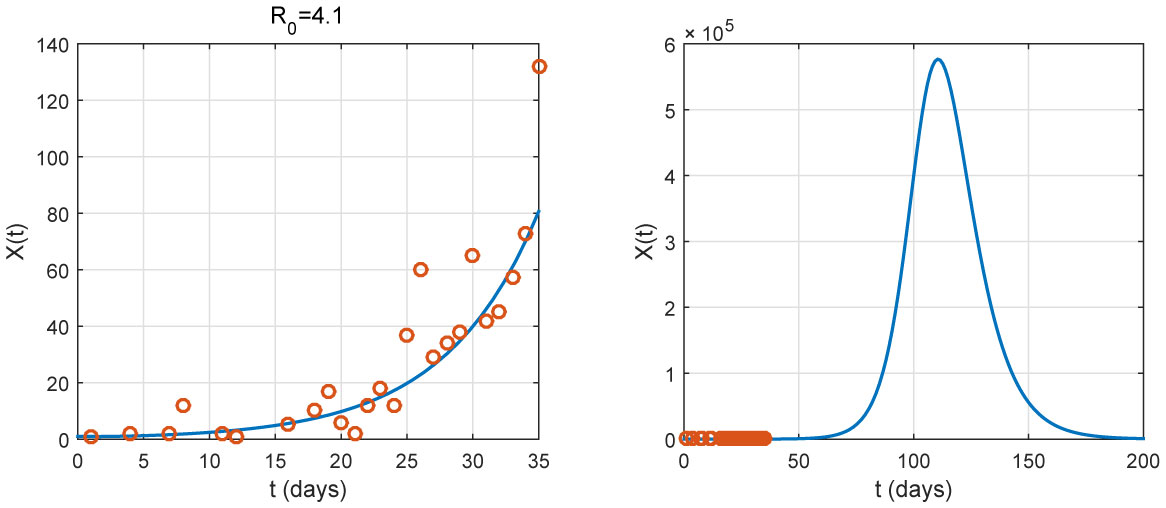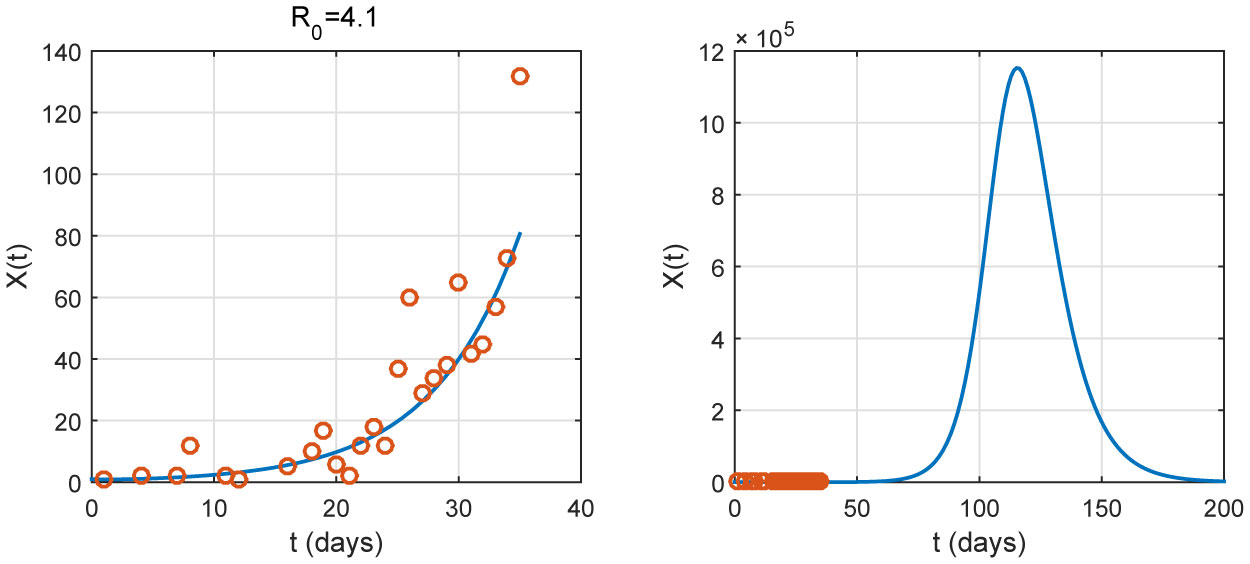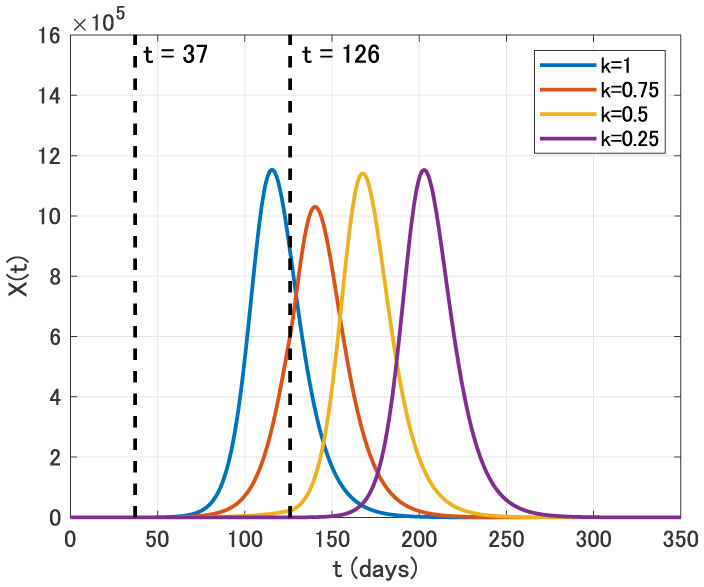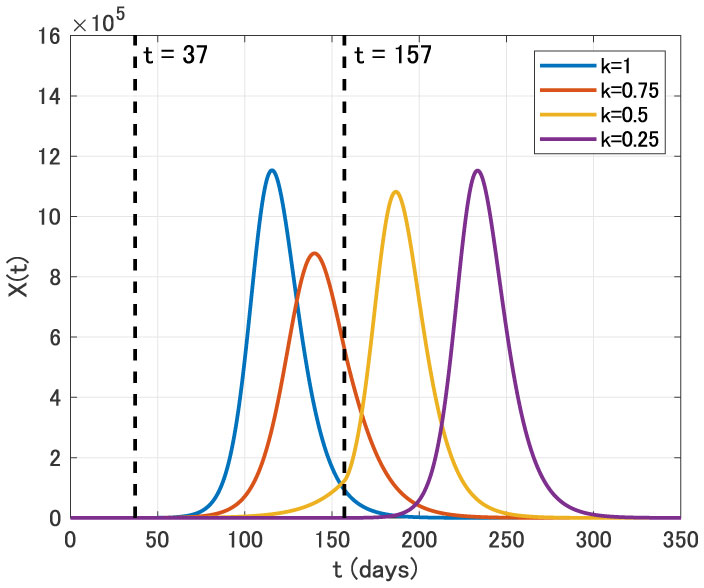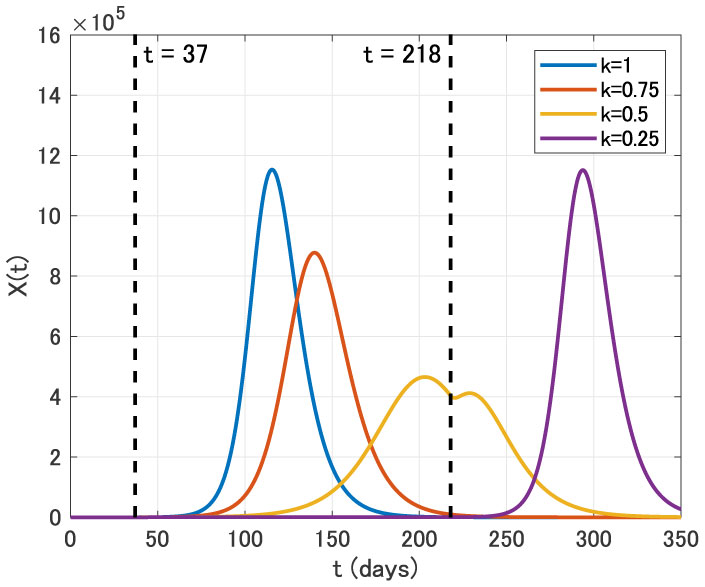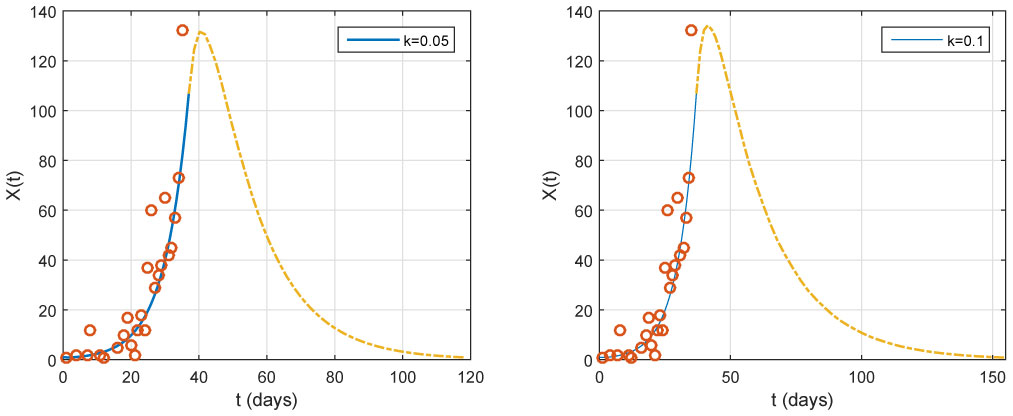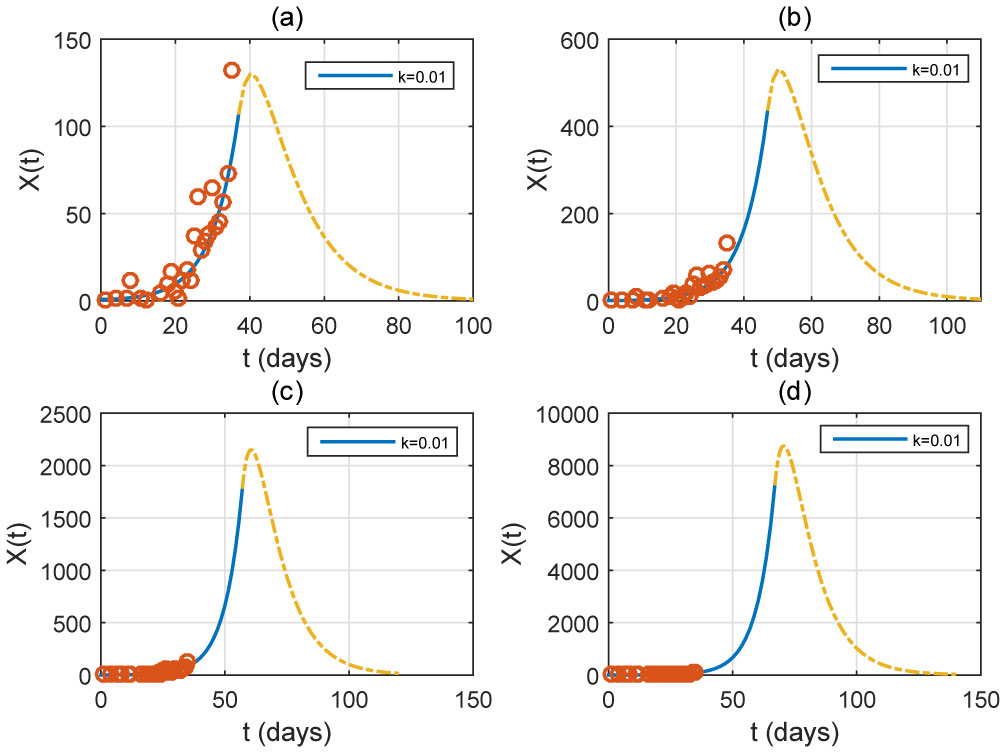| 1.
|
Ahmed A Mohsen, Hassan Fadhil AL-Husseiny, Xueyong Zhou, Khalid Hattaf,
Global stability of COVID-19 model involving the quarantine strategy and media coverage effects,
2020,
7,
2327-8994,
587,
10.3934/publichealth.2020047
|
|
| 2.
|
Aka Christian Euloge Mouvoh, Anass Bouchnita, Aissam Jebrane,
2020,
A contact-structured SEIR model to assess the impact of lockdown measures on the spread of COVID-19 in Morocco’s population,
978-1-7281-6921-7,
1,
10.1109/ICECOCS50124.2020.9314462
|
|
| 3.
|
Mohamed Lounis, Juarez dos Santos Azevedo,
Application of a Generalized SEIR Model for COVID-19 in Algeria,
2021,
5,
25424742,
em0150,
10.21601/ejosdr/9675
|
|
| 4.
|
Abdelfatah Kouidere, Driss Kada, Omar Balatif, Mostafa Rachik, Mouhcine Naim,
Optimal control approach of a mathematical modeling with multiple delays of the negative impact of delays in applying preventive precautions against the spread of the COVID-19 pandemic with a case study of Brazil and cost-effectiveness,
2021,
142,
09600779,
110438,
10.1016/j.chaos.2020.110438
|
|
| 5.
|
Anass Bouchnita, Abdennasser Chekroun, Aissam Jebrane,
Mathematical Modeling Predicts That Strict Social Distancing Measures Would Be Needed to Shorten the Duration of Waves of COVID-19 Infections in Vietnam,
2021,
8,
2296-2565,
10.3389/fpubh.2020.559693
|
|
| 6.
|
Shi Yin, Nan Zhang,
Prevention schemes for future pandemic cases: mathematical model and experience of interurban multi-agent COVID-19 epidemic prevention,
2021,
0924-090X,
10.1007/s11071-021-06385-4
|
|
| 7.
|
H. Ferjouchia, A. Kouidere, O. Zakary, M. Rachik,
Optimal control strategy of COVID-19 spread in Morocco using SEIRD model,
2021,
7,
2351-8227,
66,
10.2478/mjpaa-2021-0007
|
|
| 8.
|
Firdos Khan, Mohamed Lounis,
Short-term forecasting of daily infections, fatalities and recoveries about COVID-19 in Algeria using statistical models,
2021,
10,
2314-8543,
10.1186/s43088-021-00136-5
|
|
| 9.
|
M. Y. Hamada, Tamer El-Azab, H. El-Metwally,
Bifurcations and dynamics of a discrete predator–prey model of ricker type,
2023,
69,
1598-5865,
113,
10.1007/s12190-022-01737-8
|
|
| 10.
|
Lin Feng, Ziren Chen, Harold A. Lay Jr., Khaled Furati, Abdul Khaliq,
Data driven time-varying SEIR-LSTM/GRU algorithms to track the spread of COVID-19,
2022,
19,
1551-0018,
8935,
10.3934/mbe.2022415
|
|
| 11.
|
Zhenyong Li, Ting Li, Weijun Xu, Yan Shao,
Dynamic modelling and optimal control of herd behaviour with time delay and media,
2022,
10,
2164-2583,
789,
10.1080/21642583.2022.2123059
|
|
| 12.
|
Svetozar Margenov, Nedyu Popivanov, Iva Ugrinova, Stanislav Harizanov, Tsvetan Hristov,
2022,
2528,
0094-243X,
080010,
10.1063/5.0106519
|
|
| 13.
|
Abdelhamid Ajbar, Rubayyi T. Alqahtani, Mourad Boumaza,
Dynamics of an SIR-Based COVID-19 Model With Linear Incidence Rate, Nonlinear Removal Rate, and Public Awareness,
2021,
9,
2296-424X,
10.3389/fphy.2021.634251
|
|
| 14.
|
Abdennour Sebbagh, Sihem Kechida,
EKF-SIRD model algorithm for predicting the coronavirus (COVID-19) spreading dynamics,
2022,
12,
2045-2322,
10.1038/s41598-022-16496-6
|
|
| 15.
|
Patikiri Arachchige Don Shehan Nilmantha Wijesekara, Yu-Kai Wang,
A Mathematical Epidemiological Model (SEQIJRDS) to Recommend Public Health Interventions Related to COVID-19 in Sri Lanka,
2022,
2,
2673-8112,
793,
10.3390/covid2060059
|
|
| 16.
|
Marcelo Bongarti, Luke Diego Galvan, Lawford Hatcher, Michael R. Lindstrom, Christian Parkinson, Chuntian Wang, Andrea L. Bertozzi,
Alternative SIAR models for infectious diseases and applications in the study of non-compliance,
2022,
32,
0218-2025,
1987,
10.1142/S0218202522500464
|
|
| 17.
|
Ran Liu, Lixing Zhu,
Specification testing for ordinary differential equation models with fixed design and applications to COVID-19 epidemic models,
2023,
180,
01679473,
107616,
10.1016/j.csda.2022.107616
|
|
| 18.
|
Mohamed Mehdaoui, Abdesslem Lamrani Alaoui, Mouhcine Tilioua,
Dynamical analysis of a stochastic non-autonomous SVIR model with multiple stages of vaccination,
2022,
1598-5865,
10.1007/s12190-022-01828-6
|
|
| 19.
|
M.T. Rouabah, A. Tounsi, N.E. Belaloui,
Genetic algorithm with cross-validation-based epidemic model and application to the early diffusion of COVID-19 in Algeria,
2021,
14,
24682276,
e01050,
10.1016/j.sciaf.2021.e01050
|
|
| 20.
|
Qu Haidong, Mati ur Rahman, Muhammad Arfan,
Fractional model of smoking with relapse and harmonic mean type incidence rate under Caputo operator,
2023,
69,
1598-5865,
403,
10.1007/s12190-022-01747-6
|
|
| 21.
|
Yudan Ma, Ming Zhao, Yunfei Du,
Impact of the strong Allee effect in a predator-prey model,
2022,
7,
2473-6988,
16296,
10.3934/math.2022890
|
|
| 22.
|
Yuncheng Xu, Xiaojun Sun, Hua Hu,
Extinction and stationary distribution of a stochastic SIQR epidemic model with demographics and non-monotone incidence rate on scale-free networks,
2022,
68,
1598-5865,
3367,
10.1007/s12190-021-01645-3
|
|
| 23.
|
Sarafa A. Iyaniwura, Musa Rabiu, Jummy F. David, Jude D. Kong, Cecilia Ximenez,
The basic reproduction number of COVID-19 across Africa,
2022,
17,
1932-6203,
e0264455,
10.1371/journal.pone.0264455
|
|
| 24.
|
Jinxing Guan, Yang Zhao, Yongyue Wei, Sipeng Shen, Dongfang You, Ruyang Zhang, Theis Lange, Feng Chen,
Transmission dynamics model and the coronavirus disease 2019 epidemic: applications and challenges,
2022,
2,
2749-9642,
89,
10.1515/mr-2021-0022
|
|
| 25.
|
Lubna Pinky, Hana M. Dobrovolny,
Epidemiological Consequences of Viral Interference: A Mathematical Modeling Study of Two Interacting Viruses,
2022,
13,
1664-302X,
10.3389/fmicb.2022.830423
|
|
| 26.
|
Antoine Baker, Indaco Biazzo, Alfredo Braunstein, Giovanni Catania, Luca Dall’Asta, Alessandro Ingrosso, Florent Krzakala, Fabio Mazza, Marc Mézard, Anna Paola Muntoni, Maria Refinetti, Stefano Sarao Mannelli, Lenka Zdeborová,
Epidemic mitigation by statistical inference from contact tracing data,
2021,
118,
0027-8424,
10.1073/pnas.2106548118
|
|
| 27.
|
Moumita Ghosh, Samhita Das, Pritha Das,
Dynamics and control of delayed rumor propagation through social networks,
2022,
68,
1598-5865,
3011,
10.1007/s12190-021-01643-5
|
|
| 28.
|
A. Sreenivasulu, B. V. Appa Rao,
Stability and controllability for Volterra integro-dynamical matrix Sylvester impulsive system on time scales,
2022,
68,
1598-5865,
3705,
10.1007/s12190-021-01688-6
|
|
| 29.
|
Chia-Hsien Tang, Yen-Hsien Lee, Win Liu, Li Wei,
Effect of the Universal Health Coverage Healthcare System on Stock Returns During COVID-19: Evidence From Global Stock Indices,
2022,
10,
2296-2565,
10.3389/fpubh.2022.919379
|
|
| 30.
|
Salih Djilali, Soufiane Bentout, Sunil Kumar, Tarik Mohammed Touaoula,
Approximating the asymptomatic infectious cases of the COVID-19 disease in Algeria and India using a mathematical model,
2022,
13,
1793-9623,
10.1142/S1793962322500283
|
|
| 31.
|
Selain Kasereka, Glody Zohinga, Vogel Kiketa, Ruffin-Benoît Ngoie, Eddy Mputu, Nathanaël Kasoro, Kyamakya Kyandoghere,
Equation-Based Modeling vs. Agent-Based Modeling with Applications to the Spread of COVID-19 Outbreak,
2023,
11,
2227-7390,
253,
10.3390/math11010253
|
|
| 32.
|
Xinghua Hu, Yimei Xu, Jianpu Guo, Tingting Zhang, Yuhang Bi, Wei Liu, Xiaochuan Zhou,
A Complete Information Interaction-Based Bus Passenger Flow Control Model for Epidemic Spread Prevention,
2022,
14,
2071-1050,
8032,
10.3390/su14138032
|
|
| 33.
|
Yue Deng, Siming Xing, Meixia Zhu, Jinzhi Lei,
Impact of insufficient detection in COVID-19 outbreaks,
2021,
18,
1551-0018,
9727,
10.3934/mbe.2021476
|
|
| 34.
|
Md. Mulk, Kazi Nusrat Islam, Md. Haider Ali Biswas,
Modeling and numerical analysis for mechanical characterization of soft tissue mechanism applying inverse finite element technique,
2023,
9,
2297-4687,
10.3389/fams.2023.1064130
|
|
| 35.
|
Yuan Yuan, Xianlong Fu,
Dynamics of an age-structured HIV model with general nonlinear infection rate,
2023,
88,
0272-4960,
308,
10.1093/imamat/hxad010
|
|
| 36.
|
Xiangyu Tang, Yujuan Chen, Mengxin Chen,
Analysis of the Diffusion SIR Epidemic Model With Networked Delay and Nonlinear Incidence Rate,
2024,
2024,
2314-4629,
10.1155/2024/5739758
|
|
| 37.
|
Ishwor Thapa, Dario Ghersi,
Modeling preferential attraction to infected hosts in vector-borne diseases,
2023,
11,
2296-2565,
10.3389/fpubh.2023.1276029
|
|
| 38.
|
Hadi Barzegar, Alireza Eshghi, Abtin Ijadi Maghsoodi, Amir Mosavi,
Optimal Control for Economic Development During the Pandemic,
2024,
12,
2169-3536,
2445,
10.1109/ACCESS.2023.3337825
|
|
| 39.
|
Ming Lu, Xu-yang Zheng, Wei-nan Jia, Chun-zhi Tian,
Analysis and prediction of improved SEIR transmission dynamics model: taking the second outbreak of COVID-19 in Italy as an example,
2023,
11,
2296-2565,
10.3389/fpubh.2023.1223039
|
|
| 40.
|
Chih-Li Sung, Ying Hung,
Efficient calibration for imperfect epidemic models with applications to the analysis of COVID-19,
2024,
73,
0035-9254,
47,
10.1093/jrsssc/qlad083
|
|
| 41.
|
Archana Mishra, Bimal Kumar Mishra, Ajit Kumar Keshri,
Quarantine Model on the Transmission of Ebola Virus Disease in the Human Population with Infectious Dead Class,
2023,
9,
2349-5103,
10.1007/s40819-023-01608-1
|
|
| 42.
|
Shuqing Yang, Chunping Jia, Jia-Fang Zhang,
Complex dynamics of an SIRS epidemic model with non-monotone incidence and saturated cure rate,
2024,
112,
0924-090X,
8695,
10.1007/s11071-024-09480-4
|
|
| 43.
|
Lahna Idres, Moundir Lassassi,
Sensitization against Covid-19 in Algeria: Which communication strategies?,
2024,
111,
22124209,
104718,
10.1016/j.ijdrr.2024.104718
|
|
| 44.
|
Marian Petrica, Ionel Popescu,
Inverse problem for parameters identification in a modified SIRD epidemic model using ensemble neural networks,
2023,
16,
1756-0381,
10.1186/s13040-023-00337-x
|
|
| 45.
|
Qi Zhou, Xinzhong Xu, Qimin Zhang,
Dynamics and calculation of the basic reproduction number for a nonlocal dispersal epidemic model with air pollution,
2023,
69,
1598-5865,
3205,
10.1007/s12190-023-01867-7
|
|
| 46.
|
Dipo Aldila, Ranandha P. Dhanendra, Sarbaz H. A. Khoshnaw, Juni Wijayanti Puspita, Putri Zahra Kamalia, Muhammad Shahzad,
Understanding HIV/AIDS dynamics: insights from CD4+T cells, antiretroviral treatment, and country-specific analysis,
2024,
12,
2296-2565,
10.3389/fpubh.2024.1324858
|
|
| 47.
|
Zia Ullah Khan, Mati ur Rahman, Muhammad Arfan, Salah Boulaaras,
The artificial neural network approach for the transmission of malicious codes in wireless sensor networks with Caputo derivative,
2024,
37,
0894-3370,
10.1002/jnm.3256
|
|
| 48.
|
Jinxiang Zhan, Yongchang Wei,
Dynamical behavior of a stochastic non-autonomous distributed delay heroin epidemic model with regime-switching,
2024,
184,
09600779,
115024,
10.1016/j.chaos.2024.115024
|
|
| 49.
|
Anwarud Din, Yongjin Li,
Ergodic stationary distribution of age-structured HBV epidemic model with standard incidence rate,
2024,
112,
0924-090X,
9657,
10.1007/s11071-024-09537-4
|
|
| 50.
|
Xin Xie, Lijun Pei,
Long-Term Prediction of Large-Scale and Sporadic COVID-19 Epidemics Induced by the Original Strain in China Based on the Improved Nonautonomous Delayed Susceptible-Infected-Recovered-Dead and Susceptible-Infected-Removed Models,
2024,
19,
1555-1415,
10.1115/1.4064720
|
|
| 51.
|
Sami Ullah Khan, Saif Ullah, Shuo Li, Almetwally M. Mostafa, Muhammad Bilal Riaz, Nouf F. AlQahtani, Shewafera Wondimagegnhu Teklu,
A novel simulation-based analysis of a stochastic HIV model with the time delay using high order spectral collocation technique,
2024,
14,
2045-2322,
10.1038/s41598-024-57073-3
|
|
| 52.
|
Abdellah Ouakka, Abdelhai Elazzouzi, Zakia Hammouch,
An SVIQR model with vaccination-age, general nonlinear incidence rate and relapse: Dynamics and simulations,
2025,
18,
1793-5245,
10.1142/S1793524523500924
|
|
| 53.
|
Arzu Unal, Elif Demirci,
Parameter estimation for a SEIRS model with COVID-19 data of Türkiye,
2023,
31,
1844-0835,
229,
10.2478/auom-2023-0041
|
|
| 54.
|
Li-Ping Gao, Can-Jun Zheng, Ting-Ting Tian, Alie Brima Tia, Michael K. Abdulai, Kang Xiao, Cao Chen, Dong-Lin Liang, Qi Shi, Zhi-Guo Liu, Xiao-Ping Dong,
Spatiotemporal prevalence of COVID-19 and SARS-CoV-2 variants in Africa,
2025,
13,
2296-2565,
10.3389/fpubh.2025.1526727
|
|
| 55.
|
Puhua Niu, Byung-Jun Yoon, Xiaoning Qian,
2024,
Calibration of Compartmental Epidemiological Models via Graybox Bayesian Optimization,
979-8-3503-5155-2,
1,
10.1109/BHI62660.2024.10913555
|
|
| 56.
|
Olumuyiwa James Peter, Oluwatosin Babasolac, Mayowa Micheal Ojo, Andrew Omame,
A mathematical model for assessing the effectiveness of vaccination in controlling Mpox dynamics and mitigating disease burden in Nigeria and the Democratic Republic of Congo,
2025,
1598-5865,
10.1007/s12190-025-02455-7
|
|
| 57.
|
Anass Bouchnita, Jean-Pierre Llored,
Les intelligences artificielles comme outils au service de la santé : limites et perspectives,
2021,
N° 2,
2606-6645,
36,
10.3917/dsso.082.0036
|
|
| 58.
|
Chaimae El Mourabit, Nadia Idrissi Fatmi,
A new model of the impact of chronic hepatitis C and its treatment on the development of tuberculosis: An optimal control and sensitivity analysis,
2025,
19,
26667207,
100574,
10.1016/j.rico.2025.100574
|
|
| 59.
|
Preeti Deolia, Vijay Shankar Sharma, Anuraj Singh,
Exploring Discrete-Time Epidemic Behavior Based on Saturated Incidence Rate and Multiple Transmission Pathways,
2025,
24,
1575-5460,
10.1007/s12346-025-01290-2
|
|
| 60.
|
Yovan Singh, Bapan Ghosh,
Dynamics of delayed models in ecology, epidemiology, and cytology: Existence of non-positive solutions,
2025,
0924-090X,
10.1007/s11071-025-11390-y
|
|









 DownLoad:
DownLoad:

